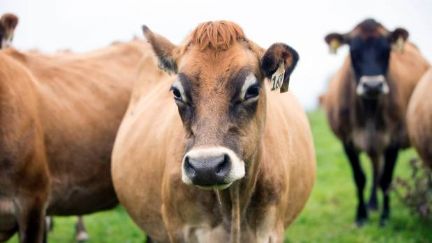| T O P I C R E V I E W |
| maryjane |
Posted - Sep 19 2018 : 12:50:55 PM

Photo: WARWICK SMITH/STUFF
What is dairy cow breeding worth and why does it matter?
Source: Stuff.co.nz
Author: ESTHER TAUNTON
It's a hard road finding the perfect cow, especially when changing consumer demand redefines what "perfect" even is.
Increasing demand for high-fat dairy products means Kiwi farmers will earn more from milkfat than protein in the 2018/19 season.
With the upward trend expected to continue, high-fat breeds and animals will become more valuable as farmers aim to get as much fat in the vat as possible.
But how does a farmer, let alone a townie, pick an animal likely to produce high-fat milk from a paddock full of swinging tails and stomping hooves?
Thanks to the Breeding Worth index, worked out by DairyNZ-owned subsidiary New Zealand Animal Evaluation, the hard work is already done.
What's the goal when breeding dairy cows?
The aim of the game – or the National Breeding Objective, as DairyNZ calls it – in New Zealand is to breed dairy cows that are able to efficiently convert feed into profit, not just milk.
The ability of a cow or bull to produce offspring able to do that is given as its Breeding Worth (BW). The higher the animal's BW, the more efficient its daughters will be at converting feed to profit.
BW is calculated by combining breeding values – an estimate of the animal's genetic merit for a trait – with economic values which reflect the value of a trait to a dairy farmer.
There are eight traits included in BW calculations, each of which has a direct economic value through either production efficiency or the robustness of the animal.
The protein and fat content of milk, as well as the volume produced, and the animal's weight are traits linked to production efficiency.
Somatic cell count (an indicator of milk quality), fertility, residual survival (how long the animal is expected to live and produce milk), and body condition score are assessed to measure robustness.
Other traits are used to improve estimations, like overall udder condition, which is used to help predict cow survival.
What's the BW of the average cow?
Zero. BW compares an animal to a "base cow", the genetic reference point for all dairy cattle in New Zealand.
The base cow is the average of a group of animals whose evaluation is set to zero to create a reference point. So if an animal has a BW of 0, its genetic merit is very similar to the base cow.
What drives a change in BW?
Milk price and the value of fat and protein are the biggest factors in the BW of dairy cattle. When those values change, it can cause a change in BW.
The economic values for fat and protein are calculated by splitting the price of milksolids into values for fat and protein, and then accounting for the cost of producing each component.
The value of fat relative to protein has been increasing for the past three seasons and this trend is forecast to continue.
DairyNZ's 2019 economic value for milkfat is $3.45 per kilogram, up 60 cents from $2.85/kg this year. The economic value of milk protein is down $1.72, from $6.06/kg to $4.34/kg.
How will that impact BW?
The BW of high fat bulls will increase while the BW of high protein bulls will fall.
DairyNZ strategy and investment leader, Dr Bruce Thorrold, said the changes in fat price had produced large shifts in BW both between and within breeds.
Of the top 200 bulls by BW in 2019, 70 per cent were jerseys, a high fat breed. Holstein-friesian animals made up 5 per cent, and the remaining 25 per cent were crossbred (jersey and holstein-friesian).
"On average, jersey bulls are increasing by $23 BW while holstein-friesian decrease by $28 BW," Thorrold said.
"Crossbred and ayrshire bulls are relatively unchanged (-$4 and -$3 BW). Within breeds, individual bulls will shift up or down by as much as $40 BW relative to their breed average shift."
What does it mean for farmers?
Farmers use BW to pick bulls for artificial insemination, decide which cows to breed from, choose heifers to buy and decide which replacements to keep.
DairyNZ said farmers would need to think about their breeding choices to ensure they had a herd capable of producing milk with higher fat content to get the best returns.
"Breeding high BW cows is vital for farm profit, so given these shifts in BW all farmers need to be thinking about their breed choice as well as individual bulls," Thorrold said.
From: https://bit.ly/2PJWqrW |
|
|
![[flourish]](/images/flourish-txt_mobius.png)
![[flourish]](/images/flourish-txt_mobius.png)